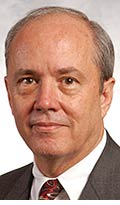Architecture prof leads effort to design energy-saving software

Charles Culp
A building energy "tune-up" procedure developed by researchers at the Texas A&M University's Energy Systems Laboratory has so far yielded more than $100 million in energy savings from little more than 300 client buildings, said Charles Culp, professor of architecture, ESL associate director and leader of the team that developed the diagnostic software used in the evaluation process.
Introduced by the ESL in 1995, the energy "tune-up", known as Continuous Commissioning, has been used by public and private sector clients in Texas and throughout the world, typically resulting in a 20 percent reduction in a building's energy consumption.
In Continuous Commissioning, ESL experts employ tools, including diagnostic software, to identify a building's energy inefficiencies, and then work with facility managers to identify and implement solutions that lead to energy savings and enhanced occupant comfort.
“ESL engineers can quickly find out what’s wrong with a building after seeing data from a building’s energy management control system processed through our software,” said Culp. “We find everything including bad thermostats, broken dampers, malfunctioning control boxes, air flows too high or too low for the needs of a space, incorrect heating and cooling schedules, and numerous other problems.”
If additional controls are needed to set cooling equipment temperatures, improve comfort or save energy, the ESL's software can estimate how much money the new equipment will save in reduced energy consumption.
“We can also calibrate the building’s heating, ventilation and air conditioning system and estimate the building’s future energy use,” said Culp.
Even buildings designed with energy efficiency in mind have realized significant declines in energy use from Continuous Commissioning.
“A new senate office building in Austin was touted as a very energy-efficient building,” said Culp. “Though it was initially very good, after it had been in operation a couple of years we went in there and lowered their energy use by more than 25 percent.”
Similarly, Austin’s city hall, designed to maximize energy use, also realized an energy savings after a Continuous Commissioning procedure.
“We were also able to reduce the city hall's energy use by more than 25 percent,” said Culp.
More than 80 buildings on Texas A&M’s College Station campus have undergone Continuous Commissioning, as have buildings at several Texas A&M System campuses, including Texas A&M International University in Laredo, where its buildings’ energy savings have been reduced between 15- 20 percent, said Culp.
In San Antonio, the Brooke Army Medical Center and Alamo Colleges are enjoying Continuous Commissioning benefits, as are buildings at Dallas/Fort Worth International Airport.
More than 30 military hospitals around the world and a dozen Veterans Administration hospitals are also benefiting from Continuous Commissioning performed by one of six practitioners licensed by the ESL.
"Continuous Commissioning has been significantly more successful than our initial estimates,” said David E. Claridge, director of the ESL and professor of mechanical engineering, who developed the process.
The program, whose cost, on average, is recouped by client energy savings in less than two years, has grown to employ more than 50 employees at the ESL and at Continuous Commissioning licensee firms.
The ESL program also readies graduate students for careers in the energy efficiency industry, said Culp.
“The industry is hurting for skilled people,” he said. “We educate people by having them work on real jobs, which gives them professional training and skills. It takes a graduate engineer a couple of years to get up to speed, then it takes another two to three years to refine their abilities.”
Culp’s classes in the Department of Architecture cover high-performance building design and simulation, environmental design and heating, ventilation and air conditioning courses and are popular with design and engineering students.
He is a fellow in the American Society of Heating, Refrigerating and Air-Conditioning Engineers, is a past president of the group's College of Fellows and currently serves on its board of directors.
Previous post
Tags
- architecture
- energy
- energy sustainability
- energy systems
- environment
- feature
- graduate work
- interdisciplinary
- research
- rss
- sustainability
- technology
Related Posts

Light pipe tests under way at daylighting lab
Ph.D. study eying occupancy-based HVAC system
Texans realize energy savings from ESL recommended codes
Students craft useful building software plugins for Revit

Texas A&M researchers enabling buildings to ‘breathe’
Follow Us
Facebook Twitter Vimeo Youtube Flickr RSS
Recent Posts

Planning prof heads study of disaster housing aid

A message from the dean

Former student remembered as expert planner

Leading educator named new head of Architecture Dept.





_thumbnail_small.png)
